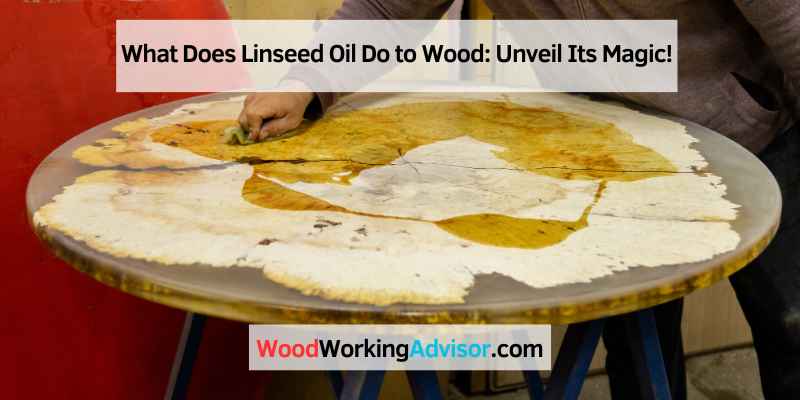Linseed oil enhances wood by providing protection and a rich, glossy finish. It penetrates deeply, preserving the wood’s natural beauty.
Linseed oil, extracted from flax seeds, is a popular choice for wood treatment. It offers a natural and eco-friendly solution for maintaining wood surfaces. This oil seeps into the wood, creating a durable barrier against moisture and wear. Wood treated with linseed oil gains a warm, lustrous appearance.
Linseed oil is ideal for both interior and exterior wood applications. It is easy to apply and helps to extend the lifespan of wood items. Whether you’re working on furniture, floors, or outdoor structures, linseed oil can be a valuable addition to your wood care routine.
The Essence Of Linseed Oil
Linseed oil comes from flax seeds. Farmers grow flax plants. They harvest the seeds from these plants. Workers then press the seeds to get oil. This process is called extraction. Cold pressing is the best method. It keeps the oil pure and strong.
Linseed oil has special properties. It dries when exposed to air. This makes it perfect for wood. The oil seeps into wood pores. It hardens and protects the wood. The oil also gives a warm, rich finish.
Linseed oil has a simple composition. It contains fatty acids. These acids help protect and nourish the wood. The main fatty acid is alpha-linolenic acid. It gives the oil its unique qualities.
Linseed Oil And Wood: A Perfect Match
Linseed oil soaks into wood easily. It gives wood a rich color. The oil enhances the natural beauty. Wood feels smoother after oiling. It also gets a slight shine. The oil protects wood from drying out. This keeps the wood strong and durable. Linseed oil is safe and natural. It’s great for all types of wood.
Linseed oil hardens inside the wood. This makes the wood surface stronger. The oil forms a protective layer. Water can’t easily damage the wood. Linseed oil also fights against pests. The oil creates a barrier against insects. It helps to stop mold growth. The chemical bond is long-lasting. This means the wood stays protected for a long time.
Protective Shield

Linseed oil protects wood from water. It forms a barrier on the surface. This barrier keeps moisture out. Wood stays dry and strong. The oil soaks into the wood. This makes the wood waterproof. It helps to prevent swelling and cracking. Wood lasts longer with this protection.
Linseed oil also protects wood from the sun. Sunlight can damage wood over time. The oil blocks harmful UV rays. This keeps the wood from fading. The wood color stays rich and vibrant. The oil helps to maintain the wood’s natural beauty. Protect your wood from sun damage with linseed oil.
Enhancing Beauty
Linseed oil makes wood colors deeper. It brings out the natural beauty. The oil seeps into the wood. This makes colors rich and warm. Light and dark shades become more vivid. Wood looks more elegant and timeless.
The oil highlights the wood grain. Each line and pattern stands out. Wood looks more detailed and interesting. The texture feels more pronounced. This gives a unique character to each piece. Linseed oil makes the wood’s natural design shine.
Durability And Maintenance
Linseed oil makes wood last longer. It protects wood from damage. This oil stops water from getting in. Wood stays strong for many years. Linseed oil also prevents cracks. Your wood looks good for a long time.
Linseed oil is easy to use. You can apply it with a cloth. It dries fast and needs reapplication every year. You do not need special tools. This oil makes wood care simple.
Application Techniques
Linseed oil deeply penetrates wood, enhancing its natural grain and providing a protective barrier against moisture and wear. It brings out the rich color and texture of the wood, giving it a warm, polished finish.
Preparation Steps
Clean the wood surface. Remove any dust or debris. Sand the wood if needed. Ensure the surface is smooth. Wipe away any sanding dust. Use a cloth for this step. Make sure the wood is dry. Wet wood won’t absorb oil well.
Best Practices
Apply linseed oil with a clean cloth. Rub in the direction of the grain. Use thin, even coats. Let the oil soak in. Wipe off excess oil. Allow the wood to dry. Repeat the process if needed. Multiple coats give better protection. Store linseed oil safely. Follow safety guidelines.
Eco-friendly And Safe
Linseed oil is safe for wood. It has no harmful chemicals. Kids and pets stay safe around it. People with allergies can use it too. It is a natural product from flax seeds. This makes it eco-friendly and biodegradable.
Linseed oil is eco-friendly. It comes from renewable resources. The oil breaks down naturally. This means less pollution. Wood treated with linseed oil lasts longer. This reduces the need for more trees. Choosing linseed oil helps the planet.
Real-world Applications
Linseed oil helps in restoring old furniture. It brings back the natural shine. It also protects the wood from damage. The oil fills small cracks and gaps. This makes the furniture stronger. It is easy to apply with a cloth. Regular use keeps furniture looking new.
Linseed oil is great for outdoor woodworks. It protects wood from rain and sun. The oil keeps the wood from drying out. It makes outdoor items last longer. Use it on fences, decks, and garden furniture. The oil is safe for plants and animals. A good choice for eco-friendly projects.

Frequently Asked Questions
What Are The Disadvantages Of Using Linseed Oil On Wood?
Linseed oil can yellow over time, making wood look aged. It attracts dust and takes long to dry. Regular reapplication is needed to maintain protection.
When Should I Use Linseed Oil On Wood?
Use linseed oil on wood when it appears dry or faded. Apply it every 6-12 months for maintenance.
Will Linseed Oil Darken Wood?
Yes, linseed oil will darken wood. It enhances the natural grain and gives a warm, rich finish.
Does Linseed Oil Make Wood Stronger?
Linseed oil does not make wood stronger. It enhances wood’s appearance and provides some protection against moisture.
Conclusion
Linseed oil enhances wood’s natural beauty and provides a protective layer. It’s easy to apply and eco-friendly. Regular use prevents drying and cracking, extending the wood’s life. By using linseed oil, you ensure your wooden items remain durable and visually appealing for years to come.


